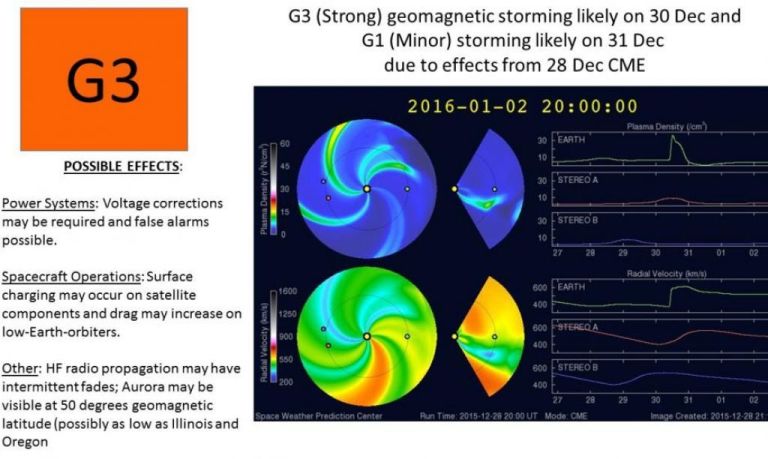A Massive Solar Storm Will Hit Earth Before New Year's Eve
The Northern Lights will be visible as far south as Oregon and possibly the Bay Area.
Most Popular
A
massive solar eruption is about to hit Earth, and the resulting
northern lights could be spectacular just before New Year's Eve for
those in the right latitudes. NOAA forecasts the aurora borealis will
dip clear down to Oregon, with a small chance of even the Bay Area
seeing the northern lights.
"It's
certainly possible," Terry Onsager, a physicist with the National
Oceanic and Atmospheric Administration told SFGATE. "It depends
entirely on the strength of the storm. If it turns out to be stronger
than that, it could be seen."
On
Monday, a powerful M1.9 class solar flare erupted from the sun. The
solar phenomenon will hit Earth early in the morning on December 30th,
and the effects could linger into New Year's Eve.
NOAA
is predicting a strong "G3" class geomagnetic storm. The rating system
classifies the magnetic fields created by these solar events on a scale
of G1 to G5. A G3 storm like what will hit this week can create
fluctuations in power grids, cause radio blackouts in the higher
latitudes, and even affect GPS reception. A less common G4 storm would
create northern lights visible in California.
Onsager
describes the coronal mass ejection as, "...a chunk of the sun's
atmosphere, mainly protons and electrons, that carries a magnetic
field."
"The whole
earth's magnetic system is embedded in this flowing 'battery,'" said
Onsager, "and that is what drives the electric currents around us."
When the electricity hits the upper atmosphere, it glows just like a neon light.
If
you're flying early in the morning on December 30th, or live in the
northern states, you're likely to see the northern lights between 2 a.m.
and 6 a.m. Wednesday.
NOAA warns:
The
geomagnetic storming watch for 30 December has been upgraded to a G3
(Strong), with a G1 (Minor) storming watch still in effect for 31
December. These watches are in response to consistent WSA-Enlil modeling
results and SWPC forecasters' determination that a coronal mass
ejection (CME) impact is likely just after mid-UTC day on 30 December
with residual CME effects continuing into 31 December. The CME impact
may cause a sudden impulse geomagnetic response at Earth, likely
resulting in the G3 conditions. The CME was associated with a
long-duration M1 flare (R1-Minor radio blackout) that peaked at 1245 UTC
(0745 ET) on 28 December, 2015. Keep checking the SWPC website for continued updates.
From: SFGate
end quote from:
-
A Massive Solar Storm will Hit Earth Before New Year's Eve
A massive solar eruption is about to hit Earth, and the resulting northern lights could be spectacular just before New Year's Eve for those in the right latitudes. NOAA forecasts the aurora borealis will dip clear down to Oregon, with a small chance of even the Bay Area seeing the northern lights. "It's certainly possible," Terry Onsager, a physicist with the National Oceanic and Atmospheric Administration told SFGATE. "It depends entirely on the strength of the storm. If it turns out to be stronger than that, it could be seen." On Monday, a powerful M1.9 class solar flare erupted from the sun. The solar phenomenon will hit Earth early in the morning on December 30th, and the effects couldPopular Mechanics q


No comments:
Post a Comment